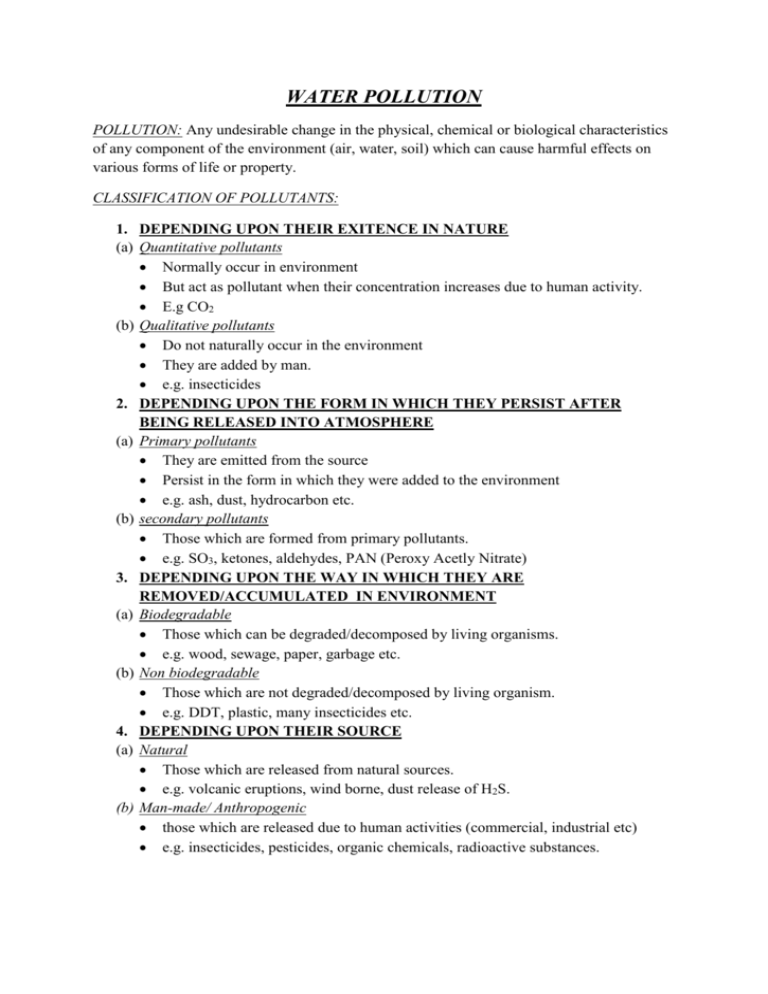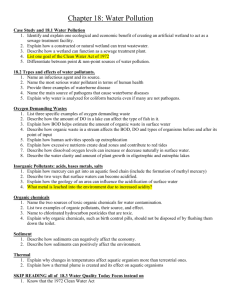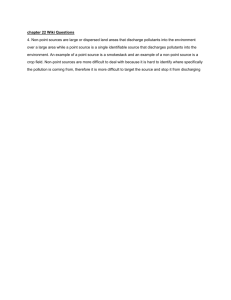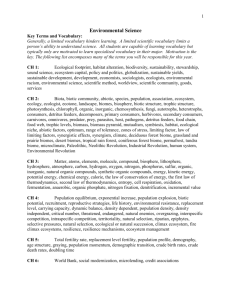File
advertisement

WATER POLLUTION POLLUTION: Any undesirable change in the physical, chemical or biological characteristics of any component of the environment (air, water, soil) which can cause harmful effects on various forms of life or property. CLASSIFICATION OF POLLUTANTS: 1. DEPENDING UPON THEIR EXITENCE IN NATURE (a) Quantitative pollutants Normally occur in environment But act as pollutant when their concentration increases due to human activity. E.g CO2 (b) Qualitative pollutants Do not naturally occur in the environment They are added by man. e.g. insecticides 2. DEPENDING UPON THE FORM IN WHICH THEY PERSIST AFTER BEING RELEASED INTO ATMOSPHERE (a) Primary pollutants They are emitted from the source Persist in the form in which they were added to the environment e.g. ash, dust, hydrocarbon etc. (b) secondary pollutants Those which are formed from primary pollutants. e.g. SO3, ketones, aldehydes, PAN (Peroxy Acetly Nitrate) 3. DEPENDING UPON THE WAY IN WHICH THEY ARE REMOVED/ACCUMULATED IN ENVIRONMENT (a) Biodegradable Those which can be degraded/decomposed by living organisms. e.g. wood, sewage, paper, garbage etc. (b) Non biodegradable Those which are not degraded/decomposed by living organism. e.g. DDT, plastic, many insecticides etc. 4. DEPENDING UPON THEIR SOURCE (a) Natural Those which are released from natural sources. e.g. volcanic eruptions, wind borne, dust release of H2S. (b) Man-made/ Anthropogenic those which are released due to human activities (commercial, industrial etc) e.g. insecticides, pesticides, organic chemicals, radioactive substances. TYPES OF ENVIRONMENTAL POLLUTION 1. 2. 3. 4. 5. Water pollution Air pollution Land pollution Noise pollution Radioactive pollution WATER POLLUTION: Definition: The presence of some foreign substances or impurities which are organic, inorganic, biological or radioactive in water in such quantity so as to constitute a health hazard by lowering the water quality and making it unfit for use. Water pollutant: It can be defined as a physical, chemical or biological factor causing aesthetic or detrimental effects on aquatic life and those who consume the water. WATER QUALITY PARAMETERS OR CHARACTERISTICS FOR WHICH ANALYSIS IS CARRIED OUT: 1. Physical characteristics 2. Chemical characteristics 3. Biological characteristics PHYSICAL CHARACTERISTICS OF WATER: Sr.No. 1. 2. 3. 4. (i) PARAMETER Colour Odour Taste Turbidity (NTU) DESIRABLE LIMIT 5 unobjectionable agreeable 5 Colour: Water in its pure form is colourless. It is coloured by the presence of foreign substances. Suspended solids give apparent colour Dissolved solids may impart true colour. This colour in water is due to presence of: Organic matter (leaves, wood, weeds etc) Industrial waste from textile & dyeing operations Mining refining Pulp and paper production etc. Environmental significance of colour: PERMISSIBLE LIMIT 25 10 For the public colour of water is not acceptable, if it is present in higher concentration than Indian standards. Highly coloured water is unsuitable for various domestic or industrial process. (ii) Taste and odour: Water is tasteless and odourless. They may be due to the presence of: Mineral salts Industrial wastes Domestic sewage Decomposing organic matter Certain types of microscopic organism Chemical compounds etc. Environmental significance of taste and odour: For public use taste and odour is not accepted. (iii) Temperature: One of the most important parameters in natural surface water systems. Biological activity increases with increase in temperature. Environmental significance of temperature: The temperature of water to be supplied should be between 10C to 20C. Temperature higher than 25C is considered objectionable. The maximum density of water occurs at 4C. (iv) Turbidity: The presence of suspended materials such as: Clay Silt Finely divided organic material Plankton Other inorganic material in water is known as turbidity. It is a measure of the extent to which light is either absorbed or scattered by suspended material in water. Environmental significance of turbidity: Clay or other inert suspended particles in drinking water may not adversely affect health. Water containing such particle may require treatment for the further use. CHEMICAL CHARACTERISTICS OF WATER: As per Indian standard SR.NO. 1. 2. 3. 4. 5. 6. 7. 8. 9. 10. 11. PARAMETER pH value Total hardness (mg/l) Iron (mg/l) Chlorides (mg/l) Residual free chlorine (mg/l) Fluoride (mg/l) Dissolved solids (mg/l) Calcium (mg/l) Magnesium (mg/l) Sulphate (mg/l) Nitrate (mg/l) DESIRABLE LIMIT 6.5 to 8.5 300 0.3 250 0.2 1.0 500 75 30 200 45 PERMISSIBLE LIMIT No relaxation 600 1.0 1000 1.5 2000 100 100 400 No relaxattion i) Total dissolved solids: The material remaining in the water after filtration for the suspended solids analysis is considered to be dissolved. They may be organic or inorganic (minerals, melts and gases) in nature. Environmental significance of total dissolved solids: ii) Dissolved substances are undesirable in water. Produce displeasing colours, taste and odour. Some chemicals may be toxic and having some carcinogenic material. pH: it is hydrogen ion concentration. Measured on pH scale which varies from 0 to 14. It decide alkalinity and acidity. Environmental significance of pH: iii) For potable water, pH should be between 6.5 to 8.5. Hardness: It is a measure of the ability of water which alters the foam formation Accounts for high consumption of soap. It is due to presence of certain salts such as carbonates, bicarbonates, chlorides and sulphates of calcium and magnesium dissolved in it. Types of hardness Temporary hardness Permanent hardness Due to the presence of carbonates and Due to the presence of chlorides, bicarbonates of calcium. sulphates and nitrates of calcium and magnesium. also known as carbonate hardness. also known as non carbonate hardness. Environmental significance of hardness: Cause excessive consumption of soap used for cleaning purpose. It also creates scale formation, in boilers. iv) Chlorides: Mainly from sea water, brine or industrial and domestic waste. Environmental significance of chlorides: Its concentration in excess of about 250 mg/l produce a noticeable taste in drinking water. Domestic water should contain less than 100 mg/l of chloride. v) Fluorides: Its small concentration can be beneficial. It is toxic to humans and other animals in large quantities. Environmental significance of fluorides: Optimum concentrations from 0.7 to 1.2 mg/l are recommended. Fluoride less than 0.1 mg/l can cause dental cavities in children. Excessive intake of fluoride can result in discolouration of teeth. CLASSIFICATION OF WATER POLLUTANTS: 1. 2. 3. 4. 5. Organic pollutants Inorganic pollutants Sediments Radioactive materials Thermal pollutants Organic pollutants: They are classified into five categories such as: i) ii) iii) iv) v) Oxygen demanding waste Disease causing waste Synthetic organic compounds Oil Sewage and agricultural runoff Oxygen demanding waste: Amount of organic pollutant in water can be estimated by finding dissolved oxygen. Oxygen demanding wastes are generally organic matter. E.g. waste from sewage, industrial waste from food processing, paper mills, agricultural returns etc. The two most important measures of oxygen demand are: a) Biochemical oxygen demand (BOD) b) Chemical oxygen demand (COD) Disease causing waste: Water pollutants are the infectious agents that cause sickness and death. Excrement from humans and other animals infected with certain pathogens. Synthetic organic compounds: Water is such an excellent solvent, it is able to hold many chemical substances. Petroleum products pollute many bodies of water. Runoff from the agriculture land which may consists of pesticides, manures etc. Inorganic pollutants: This includes inorganic salts, mineral acids, finely divided particles etc. Major sources of inorganic pollutants in water are: Suspended solids, iron, cyanide, sulphides come from iron and steel, paper and pulp industry. Acid come from wastewater of various industries. Acid destroy the bacteria and other microorganisms. Phosphates come from detergents and nitrates from fertilizers. Ferric and ferrous ions are derived from fertilizers. Chemical industries and mining activities are adding chlorides, various metals, acids etc. Sediments: They are soil and mineral particles which are washed away from land by flood waters and cause pollution of surface water. Erosion from farmlands, deforested slopes, construction sites, mining sites etc cause sedimentation. Reducing the photosynthesis process. It also kills the animals by clogging their gills and feeding structure. Radioactive substances: Radioactive wastes is enter in aquatic bodies in a following ways: Water from nuclear power plants Fallout from nuclear weapons testing Uranium ore processing Waste from research laboratories and hospitals. EUTROPHICATION: Definition: the aging of lake is known as eutrophication. Derived from eutrophos + trophic, Eutrophos = well nourished or enriched Trophic = feeding. Sources of nutrients for eutrophication: Eutrophication escalates rapidly when: 1. High amount of nutrients from fertilizers, domestic and instrustrial waste, urban drainage, detergents, animal wastes and sediments enter water streams. 2. The effluent from wastewater treatment plants is usually high in biological nutrients particularly phosphates and nitrates. 3. By leaching the rain water runoff, the phosphates and nitrates from the fertilizers get collected into streams, lakes, harbours etc. How does eutrophication occur? 1. Human activities add excessive amounts of plant nutrients to streams and lakes in various ways. 2. The runoff from agriculture fields. 3. Untreated or partially treated domestic sewage is another major source. EFFECTS OF EUTROPHICATION: 1. During eutrophication, algal bloom release toxic chemicals which kill fish, birds and other aquatic animals causing water to sink. 2. Decomposition of algal boom leads to oxygen depletion in water. 3. When O2 level falls to zero some bacteria drive oxygen through reduction of nitrates. 4. Many pathogenic microbes, viruses, protozoa and bacteria etc grow on sewage products under







